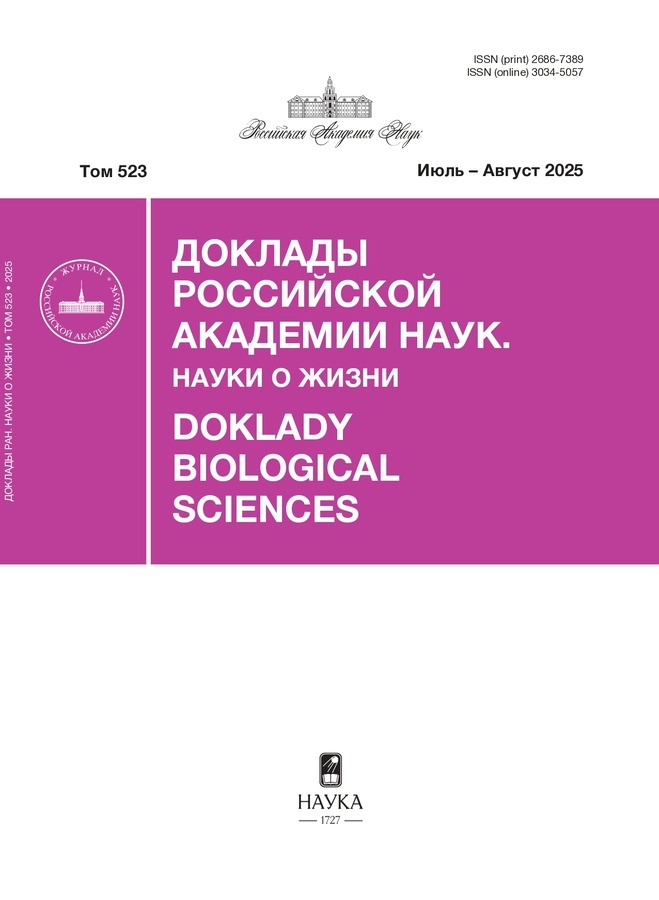FLOWERING INITIATION GENES DETERMINE THE NODE FOR INFLORENCE-EAR IN ZEA MAYS L.
- Authors: Arkhestova D.K.1,2, Kochieva E.Z.1,3, Shchennikova A.V.1
-
Affiliations:
- Institute of Bioengineering, Federal Research Center “Fundamentals of Biotechnology” of the Russian Academy of Sciences
- Institute of Agriculture – branch of the Kabardino-Balkarian Scientific Center of the Russian Academy of Sciences
- Biological Faculty, Moscow State University
- Issue: Vol 523, No 1 (2025)
- Pages: 421-425
- Section: Articles
- URL: https://freezetech.ru/2686-7389/article/view/693501
- DOI: https://doi.org/10.31857/S2686738925040075
- ID: 693501
Cite item
Abstract
The expression profile of key genes regulating flowering initiation (ID1, DLF1, ZCN6, ZCN7 and ZCN8) of Zea mays L. was determined in the leaf axils of the reproductive and adjacent nodes during the flowering initiation. The similarity of the inter-node dynamics of the ID1, DLF1, ZCN7 and ZCN8 gene expression was shown throughout the entire measurement period. It was determined that ~10 days before visual detection of the inflorescence meristem, the expression of the flowering activator genes ID1, DLF1, ZCN7 and ZCN8 significantly increased in the reproductive node compared to the adjacent nodes, while the flowering inhibitor gene ZCN6 expression decreased to trace values at all nodes.
Keywords
About the authors
D. Kh. Arkhestova
Institute of Bioengineering, Federal Research Center “Fundamentals of Biotechnology” of the Russian Academy of Sciences; Institute of Agriculture – branch of the Kabardino-Balkarian Scientific Center of the Russian Academy of Sciences
Email: shchennikova@yandex.ru
Moscow, Russian Federation; Nalchik, Russian Federation
E. Z. Kochieva
Institute of Bioengineering, Federal Research Center “Fundamentals of Biotechnology” of the Russian Academy of Sciences; Biological Faculty, Moscow State University
Author for correspondence.
Email: shchennikova@yandex.ru
Moscow, Russian Federation; Moscow, Russian Federation
A. V. Shchennikova
Institute of Bioengineering, Federal Research Center “Fundamentals of Biotechnology” of the Russian Academy of Sciences
Email: shchennikova@yandex.ru
Moscow, Russian Federation
References
- Bortiri E., Hake S. // J. Exp. Bot. 2007. V. 58(5). P. 909–916.
- Mascheretti I., Turner K., Brivio R. S., et al. // Plant Physiol. 2015. V. 168. P. 1351–1363.
- Matsuoka Y., Vigouroux Y., Goodman M. M., et al. // Proc. Natl. Acad. Sci. USA. 2002. V. 99. P. 6080–6084.
- Bonnett O. T. // Science. 1954. V. 120(3107). P. 77–87.
- Meng X., Muszynski M. G., Danilevskaya O. N. // Plant Cell. 2011. V. 23. P. 942–960.
- Corbesier L., Vincent C., Jang S., et al. // Science. 2007. V. 316. P. 1030–1033.
- Lazakis C. M., Coneva V., Colasanti J. // J. Exp. Bot. 2011. V. 62. P. 4833–4842.
- Danilevskaya O. N., Meng X., Ananiev E. V. // Plant Physiol. 2010. V. 153(1). P. 238–251.
- Colasanti J., Tremblay R., Wong A. Y., et al. // BMC Genomics. 2006. V. 7. P. 158.
- Danilevskaya O. N., Meng X., Selinger D. A., et al. // Plant Physiol. 2008. V. 147. P. 2054–2069.
- Tsuji H., Sato M. // Plant Cell Physiol. 2024. V. 65(3). P. 322–337.
- Wang Z., Yang R., Devisetty U. K., et al. // Front. Plant Sci. 2017. V. 8. P. 697.
- Ho W. W., Weigel D. // Plant Cell. 2014. V. 26. P. 552–564.
- Hanzawa Y., Money T., Bradley D. // Proc. Natl. Acad. Sci. U.S.A. 2005. V. 102. P. 7748–7753.
Supplementary files











